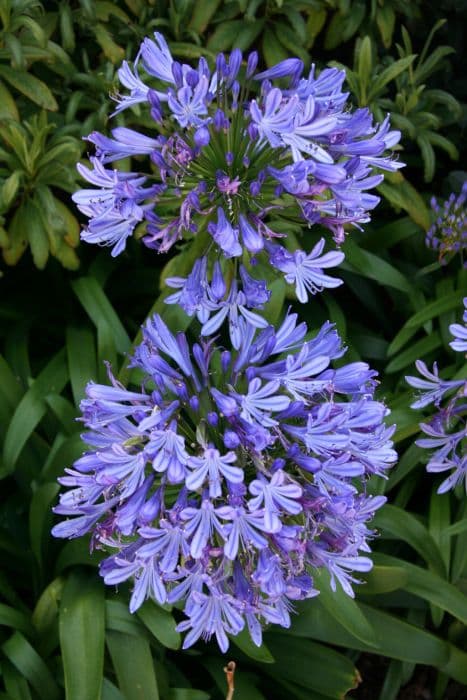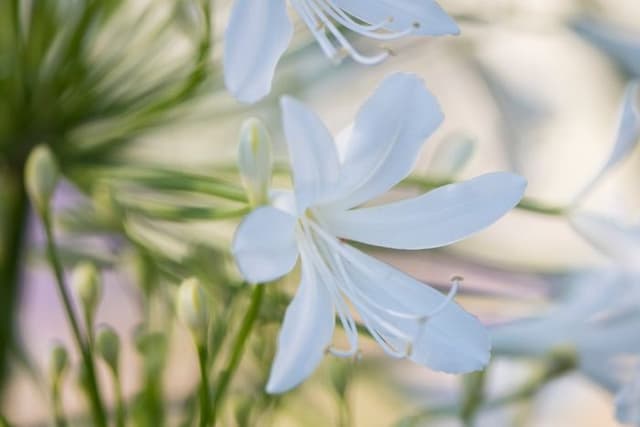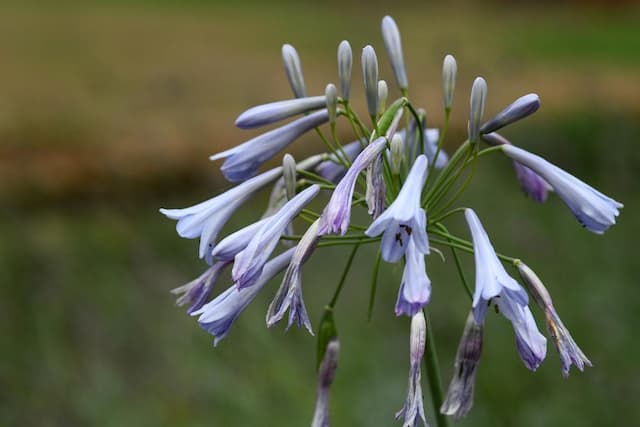African Lily Agapanthus 'Balmoral'

ABOUT
The Agapanthus 'Balmoral' is a striking perennial plant known for its lush, strap-like green leaves that arch gracefully, creating a dense, fountain-like foliage clump. The beauty of this plant is elevated by its spectacular flower display. On top of tall, slender stalks, rounded clusters of tubular flowers bloom in a beautiful shade of blue to violet, sometimes with a hint of white or a darker blue stripe running through the petals. Each globe-shaped flower head is made up of numerous individual star-shaped florets, providing an impressive round bouquet that floats elegantly above the foliage. This plant is commonly called the African Lily or Lily of the Nile, and it brings a touch of exotic elegance to any garden, combining both lush, verdant foliage with the commanding presence of its floral spheres.
About this plant
 Names
NamesFamily
Amaryllidaceae
Synonyms
African Lily, Lily of the Nile, Love Flower
Common names
Agapanthus 'Balmoral'
 Toxicity
ToxicityTo humans
African Lily (Agapanthus 'Balmoral') is considered mildly toxic if ingested. The plant contains several toxic compounds, including saponins. The symptoms of poisoning can include nausea, vomiting, and diarrhea. In some cases, ingestion can also lead to dizziness and excessive salivation. The sap from the plant can cause skin irritation or dermatitis in sensitive individuals. It is advisable to handle the plant with care and ensure it is not ingested, especially by children or vulnerable adults.
To pets
African Lily (Agapanthus 'Balmoral') is also toxic to pets, including dogs and cats. It contains compounds such as saponins which, if ingested, can cause symptoms including vomiting, diarrhea, nausea, and sometimes excessive salivation or drooling. The plant's sap may also cause skin irritation in some pets. It is important to prevent pets from accessing or consuming any part of the plant to avoid possible poisoning.
 Characteristics
CharacteristicsLife cycle
Perennials
Foliage type
Evergreen
Color of leaves
Green
Flower color
Blue
Height
2 feet (0.61 meters)
Spread
2 feet (0.61 meters)
Plant type
Bulb
Hardiness zones
8
Native area
South Africa
Benefits
 General Benefits
General Benefits- Ornamental Value: Agapanthus 'Balmoral', commonly known as Lily of the Nile, showcases striking blue or violet flowers that add aesthetic appeal to gardens and landscapes.
- Drought Tolerance: Once established, Lily of the Nile is quite drought-tolerant, making it a good choice for water-wise gardens or areas with water restrictions.
- Low Maintenance: This plant typically requires minimal upkeep, with only occasional deadheading and division every few years to maintain its vigor.
- Attracts Wildlife: The showy blooms of Lily of the Nile can attract pollinators like bees and butterflies, promoting biodiversity in the garden.
- Long Blooming Season: Lily of the Nile enjoys a long flowering period throughout the summer months, providing sustained color and interest in the landscape.
- Versatility: This plant can be used in a variety of garden settings, including borders, container gardens, and as cut flowers in floral arrangements.
- Evergreen Foliage: In milder climates, the Lily of the Nile retains its green foliage year-round, contributing to the garden's winter interest.
 Medical Properties
Medical PropertiesThis plant is not used for medical purposes.
 Air-purifying Qualities
Air-purifying QualitiesThis plant is not specifically known for air purifying qualities.
 Other Uses
Other Uses- As a natural dye: The flowers of the African lily can be used to produce a blue or green dye for fabrics and other materials.
- In art and photography: The striking blooms of the African lily make them a popular subject for both artists and photographers seeking to capture their beauty.
- As a teaching tool: Educators may use the African lily to teach students about plant biology, pollination, and horticulture practices.
- For soil erosion control: The African lily, with its thick roots, can be planted on slopes or areas prone to erosion to help stabilize the soil.
- As a companion plant: African lily can be planted alongside vegetables to enhance garden biodiversity and deter certain pests.
- In cultural ceremonies: In some cultures, the African lily might be used in ceremonial garlands or as a symbolic flower in weddings and other festivities.
- For floral art: The long-lasting blooms are often used in floral arrangements and can be an important component of ikebana, the Japanese art of flower arranging.
- In culinary presentations: Although not edible, the flowers can be used as a non-toxic decorative element in culinary dishes.
- As a natural insect repellent: When planted in the garden, the African lily can help repel certain insect species, thus protecting other plants nearby.
- For crafting: Dried stems and seed pods of the African lily can be used to create unique crafts, such as wreaths and ornaments.
Interesting Facts
 Feng Shui
Feng ShuiThe Lily of the Nile is not used in Feng Shui practice.
 Zodiac Sign Compitability
Zodiac Sign CompitabilityThe Lily of the Nile is not used in astrology practice.
 Plant Symbolism
Plant Symbolism- Love Letters: The name Agapanthus is derived from the Greek words 'agape' meaning love, and 'anthos' meaning flower. As such, it is often considered to symbolize a letter or message of love.
- Beauty: With its striking globe-shaped clusters of blue or purple flowers, the Agapanthus is often associated with beauty and visual attractiveness.
- Constancy and Endurance: This plant is tough and durable, capable of surviving in harsh conditions. It therefore comes to symbolize endurance and the ability to stand firm through trials.
- Fertility: The lush and prolific blooms may represent fertility and abundance.
 Water
WaterFor the African Lily, it's crucial to maintain a balance in watering; they prefer moist soil but don't do well in standing water. During the growing season, water generously about once a week, allowing the soil to become slightly dry between waterings. In hot, dry weather, increase watering to twice a week, ensuring each time to thoroughly saturate the soil using about 1-2 gallons depending on the size of the plant and the dryness of the soil. During winter, reduce watering to every few weeks, just enough to prevent the soil from completely drying out, especially if the plant is outdoors in a milder climate.
 Light
LightThe African Lily thrives in full sun to partial shade. Ideal lighting conditions include placing the plant in a spot where it can receive at least 6 hours of direct sunlight daily. If positioned indoors, a south-facing window would be great, ensuring it gets ample bright, indirect light for most of the day.
 Temperature
TemperatureAfrican Lilies prefer temperatures between 60 and 80 degrees Fahrenheit but can survive brief periods outside of this range. They can withstand a minimum temperature of about 50 degrees Fahrenheit but are generally not frost-tolerant. The ideal temperature conditions for active growth are within that 60 to 80 degrees Fahrenheit range.
 Pruning
PruningAfrican Lilies benefit from pruning to remove spent flower stalks and encourage further blooming. Prune immediately after the blooms fade, usually in late summer or early fall. It's also a good practice to cut back the foliage to the ground in late fall or early winter after it has died back, which will help promote healthy growth in the spring.
 Cleaning
CleaningAs needed
 Soil
SoilThe best soil mix for Agapanthus, commonly known as Lily of the Nile, should be well-draining with a loamy quality and organic rich. A pH between 6.0 and 7.0 is ideal for optimal growth. Typical mix would include two parts loam, one part perlite, and one part well-rotted compost.
 Repotting
RepottingLily of the Nile should be repotted every 3 to 4 years, or once the plant has become root-bound in its current container. It's best to repot in the spring before the growing season begins.
 Humidity & Misting
Humidity & MistingLily of the Nile prefers moderate humidity levels, but is quite adaptable and can tolerate the dry air typically found in homes. No specific humidity level is mandatory for this resilient plant.
 Suitable locations
Suitable locationsIndoor
Place in bright, indirect light and water regularly.
Outdoor
Plant in full sun or partial shade in rich soil.
Hardiness zone
8-10 USDA
 Life cycle
Life cycleAgapanthus 'Balmoral', commonly known as Lily of the Nile or African Lily, begins its life cycle when a seed germinates in spring or early summer, given adequate moisture and soil warmth. The seed develops into a seedling with a simple root system, which then grows into a young plant with distinctive strap-like leaves. As the plant matures, usually taking several years, it forms evergreen clumps of foliage and becomes more robust. During the summer, it produces tall flowering stalks topped with rounded clusters of blue or white trumpet-shaped flowers. After blooming, the flowers develop into seed capsules, and once these mature, seeds are dispersed to start a new generation. Outside of propagation by seed, Agapanthus 'Balmoral' can also be propagated by dividing the root clump in late winter or early spring, which is another important stage in the management of its life cycle.
 Propogation
PropogationPropogation time
Early spring
Agapanthus 'Balmoral', commonly known as Lily of the Nile, is best propagated through division of the plant's clumps. The optimal time to divide and propagate these plants is after flowering has finished and the plant is in a period of dormancy, typically in early spring or fall. To propagate by division, gently lift the clump from the ground using a shovel, taking care not to damage the roots excessively. The clump should then be separated into smaller sections, each with a portion of roots and at least one or two growing points or shoots. These sections can then be immediately replanted in well-draining soil, spaced about 12 to 18 inches (approximately 30 to 45 centimeters) apart to allow sufficient room for growth. Water the newly planted divisions well to help establish them in their new locations. Division is not only a popular method for its simplicity but also helps rejuvenate older plants that may have become overcrowded and less vigorous.









![African lily [Double Diamond]](/_next/image?url=https%3A%2F%2Fplants-admin.emdemapps.com%2Fimages%2Fplants%2F%2Fimages%2F604b558c4357a.png&w=640&q=75)